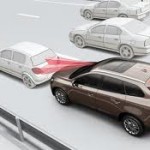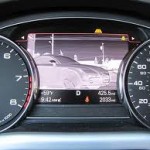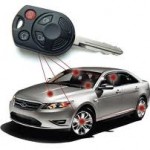The commonly used safety technologies like seat belt and airbag will work only after the accident happens. Today, the new technologies that are emerging, are more focused on avoiding the accidents or cutting down the impact of it significantly.
Listed below are few such technologies that have high potential in becoming as common in automobiles as seat-belts today.
 City safety technology
City safety technology
This technology avoids collisions between vehicles to cut minor accidents in city traffic. Volvo came up with this technology through its 2010 XC60 model.
City safety technology uses an optical radar system to monitor moving or static objects up to 20 feet ahead of the car. If the sensor detects that the collision is about to occur, City Safety uses a hydraulic pump to apply the brakes on its own. This technology works when vehicles move at a speed less than 20mph.
Statistics from Volvo shows that more than 75% of collisions occur when vehicles move at a speed less than 20mph. Engineers from Volvo predict this technology reduces such collisions by nearly 50%.
 Attention assist technology
Attention assist technology
This is a new technology from Mercedez-Benz, which uses a computer that records driver’s individual profile based on steering angle and other parameters like speed of the vehicle at the beginning of the drive and then monitors these signals.
Sensors determine the unique driving profile in the first 20 minutes of drive. A sensitive sensor monitors the steering movements and vehicle’s speed. When the car travels between a speed of 50 to 112mph, the current steering behavior is compared to the profile, the system identifies the drowsiness and provides an audible warning with a message displaying “Time for Rest?” with a coffee cup sign.
Volvo has a similar “Driver Alert Control” (DAC) system that works when car’s speed exceeds 65 kmph. It makes an alarm when the driver gets too close to the markings of another car. Similarly BMW’s Lane Departure System uses a camera to monitor the lines on the road ahead, and makes the steering wheel rumble if a driver crosses a line without a turn signal.
Yawn detection technology, is almost similar to attention assist technology, in which an eye tracker alerts the driver by giving away an alarm. Sensors detect the lip movement and eye lid movement. If the driver closes his eyes for longer than a user-defined interval the camera detects and sounds an alarm. The cameras evaluate more than 200 images per second to identify the line of vision, even when a drivers head moves to right or left.
 Adaptive Cruise Control
Adaptive Cruise Control
Traditional cruise control was first used in 1958 Chrysler model cars. It was helpful in long drives, but the driver has to judge the closing distance between his vehicle and the one that is in the front. Adaptive cruise control system was developed to overcome this drawback.
When the ACC system is activated, a light-based microwave radar unit that is located in front of the vehicle scans for a distance of nearly 500 feet in front of the vehicle and if the system identifies an object, it then calculates the distance and relative speed. Then the on-board computer automatically sends a message to apply brakes to keep up a pre-programmed distance behind the object.
 Night vision with pedestrian detection
Night vision with pedestrian detection
This system works with the help of two technologies: near infrared system (NIR) and far infrared system (FIR).
Far infrared system detects the thermal emissions from the objects and surfaces of road and generates images, while the Near Infrared System actively illuminates the objects in the near infrared spectrum and captures the reflected radiations.
This system helps to overcome the problem caused by darkness as it detects the person and warns the driver. If the driver fails to apply brake, the car takes over and stops before the impact occur. If the driver turns the wheel, which the car interprets as he is avoiding the impact, the car avoids automatic braking. The details of night vision technologies offered by various automakers for their respective vehicles, are as follows:
- Benz offers this system at a price between $1780 and $3490 and the system can detect pedestrians upto 500 feet away.
- BMW’s night vision option costs $2600 and detects pedestrians with in a distance of 10 to 100 yards, but only works at speed of 25mph or faster.
- Audi’s Night Vision Assistant with Pedestrian Detection kit adds $2300 to the price tag.
- Lexus’s Advanced Pre-collision System with Active Pedestrian Detection System costs between $5800 on LS 600hL and $5860 on LS 460.
Automatic high-beam control
This system switches off the high beam automatically when the car encounters oncoming traffic or when another vehicle ahead comes into sight or when the approaching road is adequately illuminated. Later the system automatically switches from low beam to high beam.
The system is controlled via a camera which is integrated into the interior mirror to monitor brightness and road traffic.
The thermal imaging camera detects people, animals and objects that emit heat from a distance of up to 300 meters, then transmits a high-contrast image to the Central Control Display. As a result, the driver is informed of any potential danger that he is unable to detect with his naked eye.
 Blind spot detection and rear cross path detection technology
Blind spot detection and rear cross path detection technology
Highway congestion is the main reason behind blind spot-related accidents. Automakers are now searching for a suitable technological solution. Presently radar systems are the most effective alternative. The blind spot system consists of two radar sensors joined to a control module and two LED warning indicators placed in the side rear-view mirrors. The sensors monitor the vehicles in the adjacent lanes, thus creating a digital picture of the vehicle’s surrounding. The control module processes the digital information.
When any vehicle enters into the blind spot, the control module warns the driver by lighting the warning indicator in the appropriate side mirror.
In rear cross path detection system, the system uses the radar sensors to look to the sides for oncoming vehicles. If someone is in your path of travel, the system audibly warns you of impending disaster.
Around view monitor
This system provides bird’s eye view of the car and surroundings to its driver. Nissan’s around view monitor setup uses 4 ultra wide angle resolution cameras that are installed on all 4 sides of the car to give a 360-degree view of the vehicle.
NHTSA statistics of 2007 show that 221 people were killed in accidents that occurred while reversing a car, and approximately 14,000 were injured. With the help of this system, driver gets view of all sides of his car and these type of collisions can be avoided.
Rain light sensor
Rain light sensor controls the auto-light system and rain-sensitive wiper system.
Regarding the auto-light function, the rain-light sensor distinguishes between entering a tunnel and passing under a bridge, using front illumination sensors. It avoids the blinking in the head light when the vehicle passes under the bridge.
The rain-sensitive wipers have lenses to ensure uniform distribution of sensitivity for raindrops and fixes the time for the first wipe when there are few raindrops on the glass.
 MyKey technology
MyKey technology
According to NHTSA, teens are more likely to take risks such as speeding, not interested to wear seat-belt. To help the worried parents, Ford introduced MyKey technology. The MyKey system allows the parent to program any key through the vehicle message center, which updates the SecuriLock Passive Anti-Theft System.
When the MyKey is inserted into the ignition, the system reads the transponder chip in the key and immediately identifies the MyKey code, and enables certain default driving modes, including belt minder with audio mute and a message “Buckle up to unmute Radio”, and earlier low-fuel warning. If Mykey is in ignition, features such as Park-aid, blind spot information system with cross traffic alert cannot be deactivated. With this technology, parents can set the top speed limit up to 80 mph, can limit the audio volume to 44% of the total volume.
 Run flat tires
Run flat tires
A normal tire depends on the internal pressure along with the sidewall construction and multiple steel belts to support the shape. The air inside the tire acts as a pillow against bumps and uneven surfaces. When air leaves the tire, it looses its ability to hold the vehicle’s weight. It means that the tire goes flat.
A run flat tire improves the standard tire by adding supporting sidewall structure allowing the tire to reach to its nearest service station without any pressure in the tire. It uses tire pressure monitor system(TPMS) to warn the driver about the pressure in the tire.
Run-flat tires helps the driver to continue his drive without changing the wheel for over 50miles and at a speed less than 55mph. This technology also helps in saving the space for luggage as it avoids spare wheel.
Run flat tire offer a better level of safety than a conventional tire if it has a puncture. It balances the vehicle when the air pressure in the tire goes to zero.
 GPS technology
GPS technology
Satellite technology was originally developed for the Department of Defense, and later used in telephones and finally it is available in cars.
GPS stands for Global Positioning System, provides the location on the map anywhere at anytime and under any atmospheric conditions with the help of 30 satellites revolving around the Earth.
Navigation systems are helpful not only in unfamiliar areas but also can act as significant time saver that helps you to avoid congested traffic, or to find a gas station when you run out of fuel, a restaurant when you are hungry.
Generally navigation systems are installed at factory, at a price tag of $1500 – $2500. Navigation systems can be portable or in-dash systems.
Blue-tooth Technology:
Cell phones have become essential instrument in our everyday lives, even while driving. However, there are laws and regulations in many regions against the use of a cellular phone while operating a car. Apart from law, distracted driving is also proved to be fatal by NHTSA which says that 20% of injury crashes in 2009 were due to distracted driving. In 2009, 5,474 people were killed and approximately 448,000 people were injured in crashes that were occurred due to distracted driving.
By using a blue-tooth device, drivers will not need to grasp the phone to have a conversation. Your hands stay put on the steering and eyes on the street. In reality the process is the same as talking to somebody next to you. Blue-tooth in automobiles enhance simplicity of making or taking a telephone call and allow the driver to focus on driving correctly. It is indisputably a superior alternative than not employing one. Some cars come with blue-tooth systems as standard equipment. For a car without that system, can still get it installed at costs about $300.
Four years ago, only some auto manufacturers, such as BMW, Lexus and Chrysler offered Blue-tooth in certain models. Now, many car makers are providing it as a factory-installed option, not only for high-end cars, but also in affordable models such as Nissan Sentra and Ford Focus.
Honda recently announced it added Blue-tooth to its 2009 Civic EX models equipped with GPS navigation. With the popularity of GPS devices, GPS chip makers such as Texas Instruments, Broadcom and Britain’s CSR, have started adding Blue-tooth, as well as FM radio transistors and GPS devices.
 Vehicle 2 vehicle communication system:
Vehicle 2 vehicle communication system:
Future cars may not fly in air but may communicate with each other. Federal Government wants to reduce collisions through vehicle 2 vehicle communication system or vehicle 2 infrastructure integration. A study by the National Highway Traffic Safety Administration estimated that connected-vehicle technology could help prevent up to 81% of crashes that don’t involve an impaired driver.
Drivers get warnings about highway congestion and suggest them to find another route there by reducing a significant portion of the estimated 3.9 billion gallons of gasoline wasted annually by cars idling in traffic jams.
All these technologies are the result of competitive innovation among auto makers to make driving of their customers more safer. Apart from gaining customer loyalty, these technologies do save more and more lives and limbs due to accidents while driving.